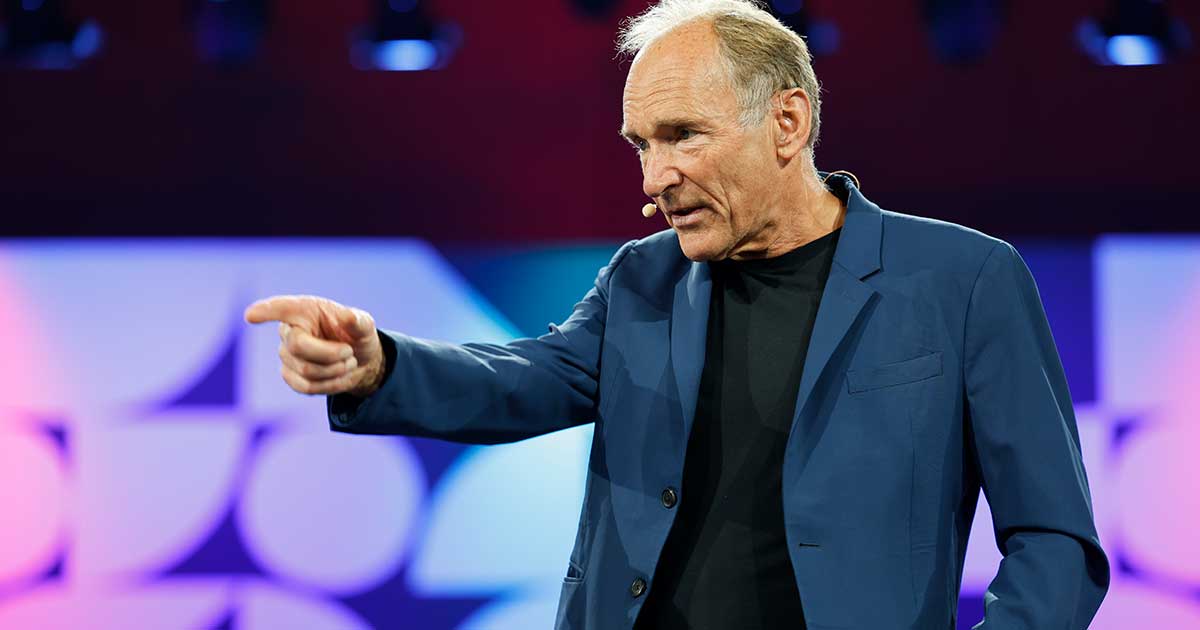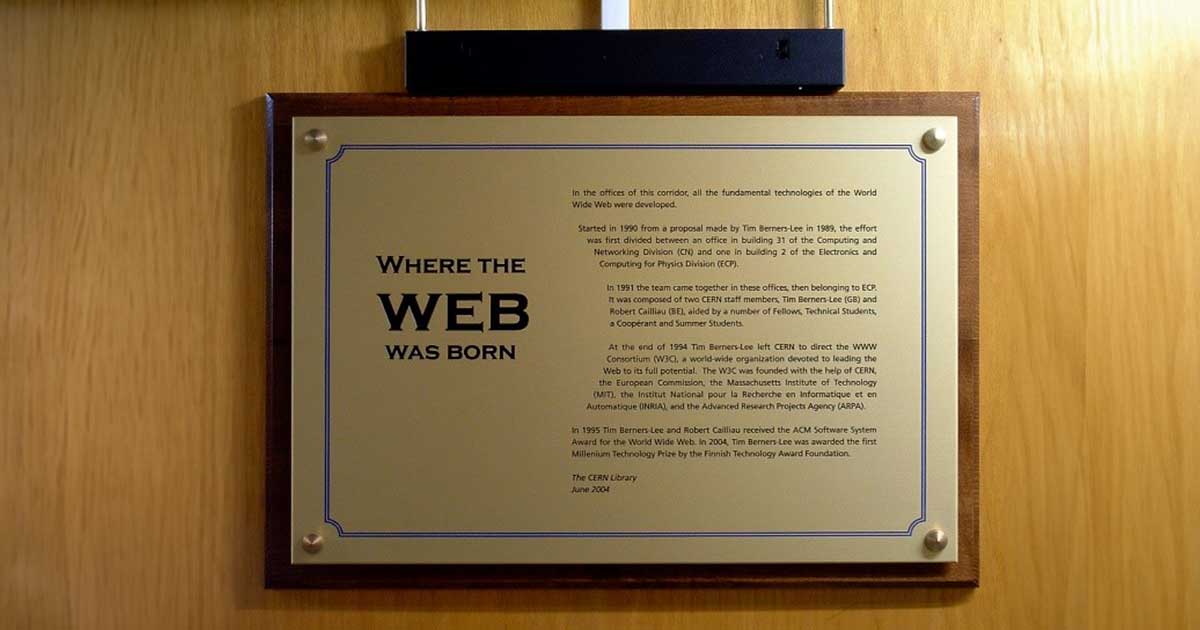Tim Berners-Lee, Web inventor
By Kiron Kasbekar | 19 Jan 2024

There are hundreds of inventions we see around us that were created in the past century. Made of solid stuff, made from steel, copper, glass, petroleum, plastic, synthetic fibers and such other tangible materials. And there are countless creations made from intangible stuff. The stuff of ideas, such as poems, stories, novels, jokes …
And then there is the Internet – neither a tangible thing we can reach out and touch, nor something intangible like poetry or fiction, entirely in our imagination though usually shared, but something with a definite form and structure that we can see but cannot touch, smell or taste.

It has become the stuff of life for a very large number of people – even more real than reality itself, for many.
The late 1950s
Back in the late 1950s computer science was an emerging discipline. Computers were monstrous machines occupying large rooms and doing little compared with what today’s computers do. And because there were so few of them, they had to be used very, very sparingly, and they had to be shared by people, who would seek and get fixed time slots in which to access the machines.

Then some scientists and engineers decided that if they could interconnect computers they would create more value for users. And then, before long, some of them thought it might be a good idea to connect computers located in different locations, near and far. Researchers in the United States, the United Kingdom and France created the Internet Protocol Suite, a set of rules they could be used to communicate between networks and devices on the Internet.
It was against this background that Timothy John Berners-Lee planted the seeds that have grown into the complex Internet world in which we now work.
Berners-Lee was born on 8th June 1955 in London, in Britain, in a family of mathematicians and scientists. His environment was steeped in intellectual curiosity and exploration. His parents, Mary Lee Woods and Conway Berners-Lee, fostered an atmosphere of learning, and encouraged their son’s interest in technology.
His formative years provided him with a solid foundation in mathematics and science. And when his parents gifted him a Ferranti Mark 1 computer, an antique from the 1950s, he began to tinker with it and to explore programming. This early exposure to computing set the stage for his future endeavors.
After school Tim Berners-Lee studied for a degree in physics at The Queen’s College, Oxford. There he was introduced to computer programming and became enamored with the emerging field of computer science. This newfound passion for technology would prove instrumental in shaping his future life. And it led to the creation of the World Wide Web.
The World Wide Web, often referred to simply as the Web, is a global information system that allows individuals to access and share a vast array of multimedia content, including text, images, videos, and more. At its core, the web is a network of interconnected web pages and websites, all made accessible through web browsers.
This concept, which, many people today might think is simple and mundane, was a revolutionary new idea back in the 1990s. And it was not an overnight birth of a simple system but the result of years of effort and innovation.
-wiki.jpg)
In the late 1980s, Tim Berners-Lee was working in Geneva, Switzerland, as a software engineer at the European Organization for Nuclear Research, known as CERN. It was during that time that he conceived the idea of the World Wide Web. He recognized the need for a system that could facilitate the sharing of information and research among scientists at CERN, who hailed from all corners of the globe.
In March 1989 Berners-Lee proposed the plan of a hypertext system that would allow researchers to easily access and retrieve information by following links between related documents. His proposal outlined the components that would later become integral to the web’s infrastructure: HTML (hypertext markup language) for creating web pages, URLs (uniform resource locators) for addressing web resources, and HTTP (hypertext transfer protocol) for facilitating data exchange between web servers and browsers.
On 6th August 1991 Berners-Lee released the first-ever website, hosted on his NeXT computer at CERN. This site, which served as both a description of the World Wide Web project and a guide on how to create web pages, introduced the world to the concept of the web. It explained the fundamental elements of hypertext, HTML, and HTTP, and laid the groundwork for others to explore and upon it.

The release of this website marked the official birth of the World Wide Web, an invention that would profoundly impact the course of human history. In essence, the Web transformed the internet from a static collection of files into an interactive and interconnected platform, changing the way people accessed and shared information forever.

Berners-Lee’s contributions to the development of the World Wide Web are nothing short of groundbreaking. His innovations and ideas have left an indelible mark on the digital landscape. Here are some of the key concepts and technologies that he introduced:
- HTML (hypertext markup language): Berners-Lee developed HTML as the foundational language for creating web pages. HTML uses tags and attributes to structure and format content on web pages, enabling the creation of hyperlinks, headings, lists, and more.
- URLS (uniform resource locators): URLs are web addresses that allow users to locate and access specific resources on the internet. Berners-Lee’s design of URLs made it possible for users to navigate the web by typing in web addresses or clicking on hyperlinks.
- HTTP (hypertext transfer protocol): HTTP is the protocol responsible for facilitating the transfer of data between web browsers and web servers. It ensures the secure and efficient delivery of web content and was a critical component in the web’s growth
- The first Web browser and server: In addition to conceptualizing the World Wide Web, Berners-Lee built the world’s first web browser, known as ‘WorldWideWeb’ (later renamed ‘Nexus’), and the first Web server. These tools were used to demonstrate the concept of the Web and allowed users to access and navigate web pages.
- The World Wide Web Consortium (W3C): Recognizing the importance of standardization and collaboration, Berners-Lee founded the World Wide Web Consortium (W3C) in 1994. The W3C plays a central role in developing and maintaining Web standards and protocols, ensuring that the Web remains an open and universally accessible platform.
- Open source philosophy: Berners-Lee’s decision not to patent his inventions and to make the World Wide Web freely accessible to all has been instrumental in the web’s development. This open-source philosophy has allowed the web to flourish without restrictive licenses or fees.
The impact of the World Wide Web

The Web has had a profound impact on society. Some ways in which it has transformed our lives:
- Communication: The web has revolutionized communication, allowing people to connect with one another instantly through email, social media, and messaging platforms. It has made global communication accessible to individuals and businesses alike.
- Information access: The web has democratized access to information. Anyone with an Internet connection can access a vast repository of knowledge, educational resources, news, and research materials. This has leveled the playing field and expanded opportunities for learning.
- Commerce: E-commerce has become a significant driver of the global economy, with online shopping and digital payments reshaping the retail landscape. Businesses of all sizes can reach a global customer base through the web.
- Entertainment: Streaming services, online gaming, and digital media have transformed the entertainment industry. The web has made it possible for people to access a wide range of entertainment content from the comfort of their homes.
- Education: Online learning platforms and educational websites have made education more accessible and flexible. Students can access courses, tutorials, and resources from institutions worldwide.
- Social impact: The web has been a powerful tool for social change and activism. It has facilitated the spread of ideas, enabled grassroots movements, and brought attention to important social issues.
- Business and innovation: The web has fostered innovation and entrepreneurship. Startups and established companies alike leverage the Internet to develop new technologies, products, and services.
Challenges and Tim Berners-Lee’s advocacy
-wiki.jpg)
While the World Wide Web has brought about tremendous advancements, it also faces challenges and concerns that need to be addressed. Tim Berners-Lee, as a visionary and advocate for the web, has been actively engaged in addressing these issues:
- Online privacy: The collection and misuse of personal data by online platforms have raised concerns about privacy. Berners-Lee has been a vocal advocate for user control over their own data and the development of privacy-preserving technologies.
- Cybersecurity: The web’s openness also makes it susceptible to cyberattacks and threats. Berners-Lee has emphasized the importance of secure protocols and practices to protect users and their data.
- Digital inequality: Access to the web is not equal worldwide, with significant digital divides existing between regions and communities. Berners-Lee has worked to bridge this gap through initiatives like the World Wide Web Foundation, which focuses on ensuring universal web access.
- Misinformation and disinformation: The web has facilitated the rapid spread of false or misleading information. Berners-Lee has called for increased efforts to combat misinformation and ensure the accuracy of online content.
The contract for the Web
In 2019, Tim Berners-Lee launched the ‘Contract for the Web’, a global initiative aimed at addressing the challenges facing the web and guiding its future development. The contract outlines principles for governments, companies, and individuals to ensure that the Web remains open, safe, and accessible to all.
The contract’s core principles include:
- Universal access and connectivity: Ensuring affordable and widespread internet access for all.
- Respect for privacy and personal data: Protecting users’ online privacy and data rights.
- Transparency and accountability: Promoting transparency in digital policies and practices.
Conclusion: a visionary and a champion
Tim Berners-Lee’s contributions to the world are immeasurable. His invention of the World Wide Web and his unwavering commitment to openness, accessibility, and user empowerment have shaped the digital age we live in.



















